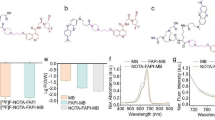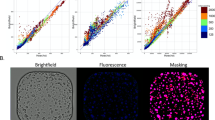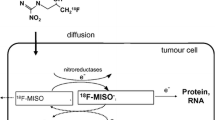Abstract
Objective
5-Aminolevulinic acid (5-ALA)–guided resection of gliomas in adults enables better delineation between tumor and normal brain, allowing improved resection and improved patients’ outcome. Recently, several reports were published regarding 5-ALA for resection of pediatric brain tumors. The aim of the study was to determine the intracellular fluorescence of protoporphyrin IX (PPIX) in pediatric brain tumors by hyperspectral imaging and to compare it with visually observed intraoperative fluorescence.
Methods
5-ALA was administered orally 4 h prior to surgery. During tumor resection, the surgeon assessed the fluorescence signal to be strong, weak, or absent. Subsequently, fluorescence intensity of tumor samples was measured via spectroscopy. In addition, clinical data, imaging, and laboratory data were analyzed.
Results
Eleven children (1–16 years) were operated. Tumor entities included three (n = 3) medulloblastomas, two (n = 2) pilocytic astrocytomas (PA), two (n = 2) anaplastic ependymomas and one (n = 1) diffuse astrocytoma, anaplastic astrocytoma (n = 1), pilomyxoid astrocytoma (n = 1) and anaplastic pleomorphic xanthoastrocytoma (n = 1). Strong fluorescence was visible in all anaplastic tumors and one PA; one PA demonstrated weak fluorescence. Visible fluorescence was strongly associated with intracellular fluorescence intensity and PPIX concentration (P < 0.05). Within all tumors with visible fluorescence, the intracellular PPIX concentration was greater than 4 μg/ml. Except for moderate and transient elevation of liver enzymes, no 5-ALA related adverse events were reported.
Conclusion
We demonstrate a strong association between intraoperative observations and spectrometric measurements of PPIX fluorescence in tumor tissue. As in former studies, fluorescence signal was more commonly observed in malignant glial tumors. Further prospective controlled trials should be conducted to investigate the feasibility of 5-ALA-guided resection of pediatric brain tumors.



Similar content being viewed by others
References
Albright AL (1993) Pediatric brain tumors. CA Cancer J Clin 43(5):272–288
Albright AL, Wisoff JH, Zeltzer P, Boyett J, Rorke LB, Stanley P, Geyer JR, Milstein JM (1995) Prognostic factors in children with supratentorial (nonpineal) primitive neuroectodermal tumors. A neurosurgical perspective from the Children’s Cancer Group. Pediatr Neurosurg 22(1):1–7
Barbagallo GMV, Certo F, Heiss K, Albanese V (2014) 5-ALA fluorescence-assisted surgery in pediatric brain tumors: report of three cases and review of the literature. Br J Neurosurg 28(6):750–754
Beez T, Sarikaya-Seiwert S, Steiger H-J, Hänggi D (2014) Fluorescence-guided surgery with 5-aminolevulinic acid for resection of brain tumors in children—a technical report. Acta Neurochir 156(3):597–604
Cage TA, Pekmezci M, Prados M, Berger MS (2013) Subependymal spread of recurrent glioblastoma detected with the intraoperative use of 5-aminolevulinic acid: case report. J Neurosurg 118(6):1220–1223
Díez Valle R, Slof J, Galván J, Arza C, Romariz C, Vidal C (2014) Observational, retrospective study of the effectiveness of 5-aminolevulinic acid in malignant glioma surgery in Spain (the VISIONA study). Neurologia 29(3):131–138
Duffner PK, Cohen ME, Myers MH, Heise HW (1986) Survival of children with brain tumors: SEER program, 1973-1980. Neurology 36(5):597–601
Eicker S, Sarikaya-Seiwert S, Borkhardt a GK, Turowski B, Heiroth H-J, Steiger H-J, Stummer W (2011) ALA-induced porphyrin accumulation in medulloblastoma and its use for fluorescence-guided surgery. Cent Eur Neurosurg 72(2):101–103
Frühwald MC, Rutkowski S (2011) Tumors of the central nervous system in children and adolescents. Dtsch Aerzteblatt Online 108(22):390–397
Idoate MA, Díez Valle R, Echeveste J, Tejada S (2011) Pathological characterization of the glioblastoma border as shown during surgery using 5-aminolevulinic acid-induced fluorescence. Neuropathology 31(6):575–582
Kaneko S, Suero Molina E, Ewelt C, Warneke N, Stummer W (2019) Fluorescence-based measurement of real-time kinetics of protoporphyrin IX after 5-aminolevulinic acid administration in human in situ malignant gliomas. Neurosurgery. https://doi.org/10.1093/neuros/nyz129
Kast RE, Skuli N, Sardi I, Capanni F, Hessling M, Frosina G, Kast AP, Karpel-Massler G, Halatsch M-E (2018) Augmentation of 5-aminolevulinic acid treatment of glioblastoma by adding ciprofloxacin, deferiprone, 5-fluorouracil and febuxostat: the CAALA regimen. Brain Sci. https://doi.org/10.3390/brainsci8120203
Kortmann RD, Kühl J, Timmermann B et al (2000) Postoperative neoadjuvant chemotherapy before radiotherapy as compared to immediate radiotherapy followed by maintenance chemotherapy in the treatment of medulloblastoma in childhood: results of the German prospective randomized trial HIT ’91. Int J Radiat Oncol Biol Phys 46(2):269–279
Louis DN, Perry A, Reifenberger G, von Deimling A, Figarella-Branger D, Cavenee WK, Ohgaki H, Wiestler OD, Kleihues P, Ellison DW (2016) The 2016 World Health Organization classification of tumors of the central nervous system: a summary. Acta Neuropathol 131(6):803–820
Merchant TE, Li C, Xiong X, Kun LE, Boop FA, Sanford RA (2009) Conformal radiotherapy after surgery for paediatric ependymoma: a prospective study. Lancet Oncol 10(3):258–266
Metellus P, Barrie M, Figarella-Branger D, Chinot O, Giorgi R, Gouvernet J, Jouvet A, Guyotat J (2007) Multicentric French study on adult intracranial ependymomas: prognostic factors analysis and therapeutic considerations from a cohort of 152 patients. Brain 130(Pt 5):1338–1349
Northcott PA, Shih DJH, Peacock J et al (2012) Subgroup-specific structural variation across 1,000 medulloblastoma genomes. Nature 488(7409):49–56
Pichlmeier U, Bink A, Schackert G, Stummer W, ALA Glioma Study Group (2008) Resection and survival in glioblastoma multiforme: an RTOG recursive partitioning analysis of ALA study patients. Neuro-Oncology 10(6):1025–1034
Preuß M, Renner C, Krupp W et al (2013) The use of 5-aminolevulinic acid fluorescence guidance in resection of pediatric brain tumors. Childs Nerv Syst 29(8):1263–1267
Regula J, MacRobert AJ, Gorchein A, Buonaccorsi GA, Thorpe SM, Spencer GM, Hatfield AR, Bown SG (1995) Photosensitisation and photodynamic therapy of oesophageal, duodenal, and colorectal tumours using 5 aminolaevulinic acid induced protoporphyrin IX--a pilot study. Gut 36(1):67–75
Robertson PL (2006) Advances in treatment of pediatric brain tumors. NeuroRX 3(2):276–291
Roth J, Constantini S (2017) 5ALA in pediatric brain tumors is not routinely beneficial. Childs Nerv Syst 33(5):787–792
Rudin CM, Hann CL, Laterra J et al (2009) Treatment of medulloblastoma with hedgehog pathway inhibitor GDC-0449. N Engl J Med 361(12):1173–1178
Ruge JR, Liu J (2009) Use of 5-aminolevulinic acid for visualization and resection of a benign pediatric brain tumor. J Neurosurg Pediatr 4(5):484–486
Schucht P, Beck J, Abu-Isa J, Andereggen L, Murek M, Seidel K, Stieglitz L, Raabe A (2012) Gross total resection rates in contemporary glioblastoma surgery: results of an institutional protocol combining 5-aminolevulinic acid intraoperative fluorescence imaging and brain mapping. Neurosurgery 71(5):927–935 discussion 935–6
Schwake M, Günes D, Köchling M, Brentrup A, Schroeteler J, Hotfilder M, Fruehwald MC, Stummer W, Ewelt C (2014) Kinetics of porphyrin fluorescence accumulation in pediatric brain tumor cells incubated in 5-aminolevulinic acid. Acta Neurochir 156(6):1077–1084
Schwake M, Nemes A, Dondrop J, Schroeteler J, Schipmann S, Senner V, Stummer W, Ewelt C (2018) In-vitro use of 5-ALA for photodynamic therapy in pediatric brain tumors. Neurosurgery 83(6):1328–1337
Schwake M, Schipmann S, Müther M, Köchling M, Brentrup A, Stummer W (2019) 5-ALA fluorescence–guided surgery in pediatric brain tumors—a systematic review. Acta Neurochir 83(6):1328–1337
Skjøth-Rasmussen J, Bøgeskov L, Sehested A, Klausen C, Broholm H, Nysom K (2015) The use of 5-ALA to assist complete removal of residual non-enhancing part of childhood medulloblastoma: a case report. Childs Nerv Syst 31(11):2173–2177
Stummer W, Stocker S, Novotny A, Heimann A, Sauer O, Kempski O, Plesnila N, Wietzorrek J (1998) In vitro and in vivo porphyrin accumulation by c6 glioma cells after exposure to 5-aminolevulinic acid. J Photochem Photobiol B 25(2–3):160–169
Stummer W, Pichlmeier U, Meinel T, Wiestler OD, Zanella F, Reulen H-J, ALA-Glioma Study Group (2006) Fluorescence-guided surgery with 5-aminolevulinic acid for resection of malignant glioma: a randomised controlled multicentre phase III trial. Lancet Oncol 7(5):392–401
Stummer W, Reulen H-J, Meinel T et al (2008) Extent of resection and survival in glioblastoma multiforme: identification of and adjustment for bias. Neurosurgery 62(3):564–576 discussion 564-76
Stummer W, Rodrigues F, Schucht P et al (2014) Predicting the “usefulness” of 5-ALA-derived tumor fluorescence for fluorescence-guided resections in pediatric brain tumors: a European survey. Acta Neurochir 156(12):2315–2324
Stummer W, Tonn J-C, Goetz C, Ullrich W, Stepp H, Bink A, Pietsch T, Pichlmeier U (2014) 5-Aminolevulinic acid-derived tumor fluorescence. Neurosurgery 74(3):310–320
Timmermann B, Kortmann RD, Kühl J, Meisner C, Slavc I, Pietsch T, Bamberg M (2000) Combined postoperative irradiation and chemotherapy for anaplastic ependymomas in childhood: results of the German prospective trials HIT 88/89 and HIT 91. Int J Radiat Oncol Biol Phys 46(2):287–295
Timmermann B, Kortmann R-D, Kühl J, Meisner C, Dieckmann K, Pietsch T, Bamberg M (2002) Role of radiotherapy in the treatment of supratentorial primitive neuroectodermal tumors in childhood: results of the prospective German brain tumor trials HIT 88/89 and 91. J Clin Oncol 20(3):842–849
Tonn J-C, Stummer W (2008) Fluorescence-guided resection of malignant gliomas using 5-aminolevulinic acid: practical use, risks, and pitfalls. Clin Neurosurg 55:20–26
Valdes PA, Kim A, Brantsch M, Niu C, Moses ZB, Tosteson TD, Wilson BC, Paulsen KD, Roberts DW, Harris BT (2011) Aminolevulinic acid-induced protoporphyrin IX concentration correlates with histopathologic markers of malignancy in human gliomas: the need for quantitative fluorescence-guided resection to identify regions of increasing malignancy. Neuro-Oncology 13(8):846–856
Valdés PA, Leblond F, Kim A et al (2011) Quantitative fluorescence in intracranial tumor: implications for ALA-induced PpIX as an intraoperative biomarker. J Neurosurg 115(1):11–17
Valdes PA, Jacobs VL, Wilson BC, Leblond F, Roberts DW, Paulsen KD (2013) System and methods for wide-field quantitative fluorescence imaging during neurosurgery. Opt Lett 38(15):2786–2788
Wisoff JH, Boyett JM, Berger MS et al (1998) Current neurosurgical management and the impact of the extent of resection in the treatment of malignant gliomas of childhood: a report of the Children’s Cancer Group trial no. CCG-945. J Neurosurg 89(1):52–59
Author information
Authors and Affiliations
Corresponding author
Ethics declarations
Conflict of interest
Walter Stummer has received consultant fees from medac, (Wedel, Germany), Carl Zeiss Meditech (Oberkochen, Germany), and NxDc (Lexington, KY, USA). All other authors certify that they have no affiliations with or involvement in any organization or entity with any financial interest (such as honoraria; educational grants; participation in speakers’ bureaus; membership, employment, consultancies, stock ownership, or other equity interest; and expert testimony or patent-licensing arrangements), or non-financial interest (such as personal or professional relationships, affiliations, knowledge or beliefs) in the subject matter or materials discussed in this manuscript.
Ethical approval
All procedures performed in studies involving human participants were in accordance with the ethical standards of the institutional ethical committee and with the 1964 Helsinki declaration and its later amendments or comparable ethical standards (2019-400-f-S).
Informed consent
Informed consent was obtained from all individual participants included in the study.
Additional information
Publisher’s note
Springer Nature remains neutral with regard to jurisdictional claims in published maps and institutional affiliations.
This article is part of the Topical Collection on Pediatric Neurosurgery
Rights and permissions
About this article
Cite this article
Schwake, M., Kaneko, S., Suero Molina, E. et al. Spectroscopic measurement of 5-ALA-induced intracellular protoporphyrin IX in pediatric brain tumors. Acta Neurochir 161, 2099–2105 (2019). https://doi.org/10.1007/s00701-019-04039-4
Received:
Accepted:
Published:
Issue Date:
DOI: https://doi.org/10.1007/s00701-019-04039-4




